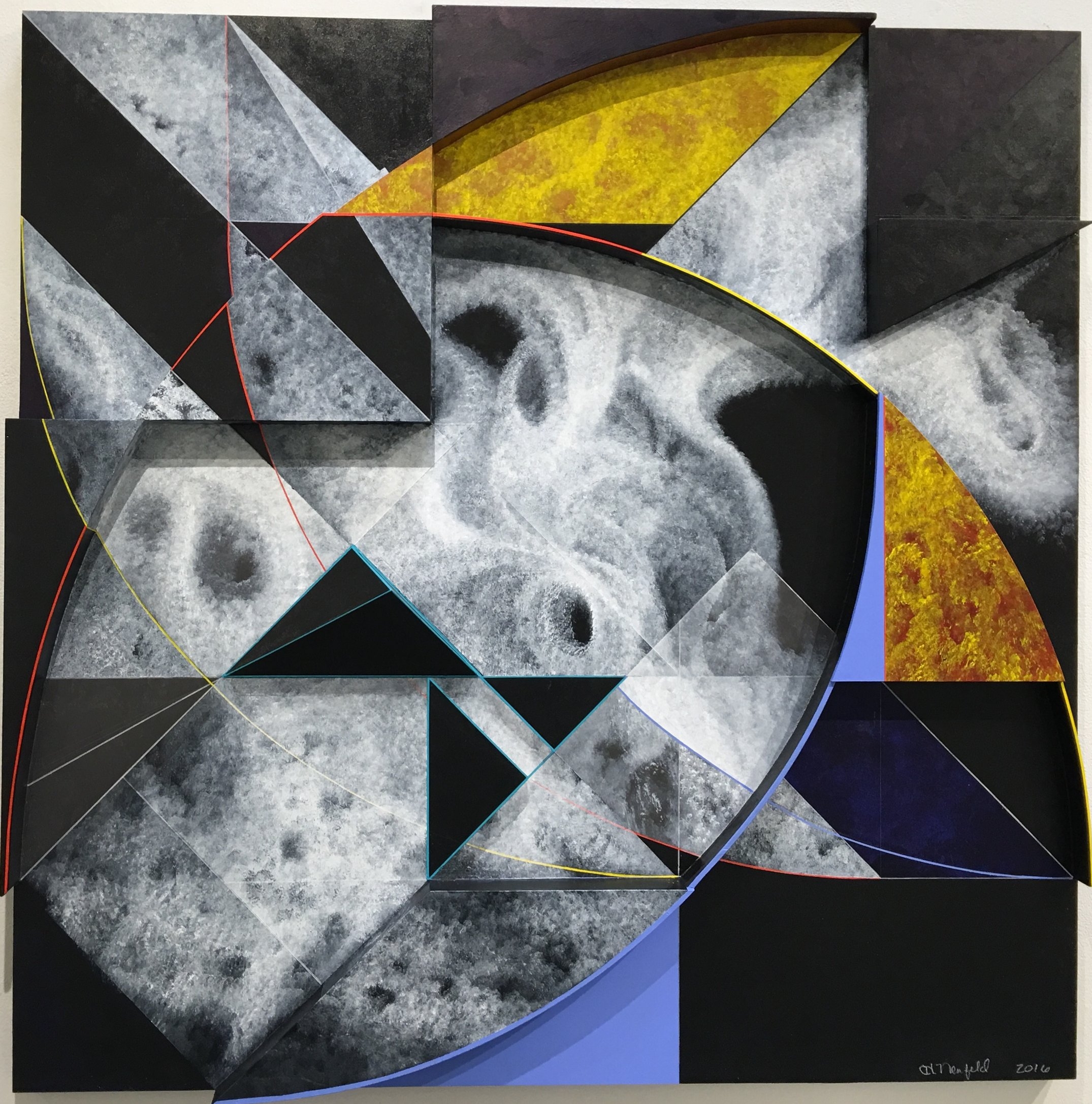
"The Wall" (titled after the cave walls where some 30,000 year old paintings were discovered) was developed over a two-year period and was instrumental in learning to work with the Process to form the Chaos. It is a "dyptic" made of two panels that work as a single painting. Additionally, it is one of the first paintings that I started to experiment with using shallow (1 1/2" high) bas-relief shapes within the different Phi configurations. The "descriptive" illusions in the upper-central area were inspired by photos taken from the Hubble telescope. Using "description" was something I decided not to pursue because of the "intent" aspect I wanted to avoid. Instead, I continued to develop what I call Process with other paintings and set this one aside and finished it later. The images of white-over-black "disclosed" a tendency for circular directions in the Process that I was unaware of during it's painting. I know that it looks so "intentional," but the spiral seemed to just happen with out trying to get any specific effect. I was completely taken by surprise.


This is the first painting of this Series. It also marks the beginning of using optical illusions as well as the Chaos placed in the "field." What looks like a shadow cast from an overhang between the two white shapes is an illusion - both shapes are constructed as one flat shape.

This is the second painting of this Series. As in "Einstein's Prism," I've included some optical illusions called "tromp' e loil" or "fools the eye." I plan to continue this Series in future paintings. If you look carefully at both of these paintings in this Series, you can see the physical form of a Phi rectangle coming off the lower-right corner, tilted toward the center of the painting at a 45 degree angle.

This is the first painting where I used what I call a "hybrid" grid in the Structure. It's a combination of the "cruciform" grid and the square



This was an extremely difficult painting; not in the Structure but in painting the Chaos. Sometimes I hit a wall. Every painter will tell you that on occasion this happens. At any rate, I wound up completely starting over and re-painting the Chaos no less than four times before things just "clicked" to conclusion. I'm surprised this doesn't happen more often because of the absence of "intention" in painting the Chaos Process. I'm extremely pleased with the way things turned out.








"The Wall" (titled after the cave walls where some 30,000 year old paintings were discovered) was developed over a two-year period and was instrumental in learning to work with the Process to form the Chaos. It is a "dyptic" made of two panels that work as a single painting. Additionally, it is one of the first paintings that I started to experiment with using shallow (1 1/2" high) bas-relief shapes within the different Phi configurations. The "descriptive" illusions in the upper-central area were inspired by photos taken from the Hubble telescope. Using "description" was something I decided not to pursue because of the "intent" aspect I wanted to avoid. Instead, I continued to develop what I call Process with other paintings and set this one aside and finished it later. The images of white-over-black "disclosed" a tendency for circular directions in the Process that I was unaware of during it's painting. I know that it looks so "intentional," but the spiral seemed to just happen with out trying to get any specific effect. I was completely taken by surprise.
This is the first painting of this Series. It also marks the beginning of using optical illusions as well as the Chaos placed in the "field." What looks like a shadow cast from an overhang between the two white shapes is an illusion - both shapes are constructed as one flat shape.
This is the second painting of this Series. As in "Einstein's Prism," I've included some optical illusions called "tromp' e loil" or "fools the eye." I plan to continue this Series in future paintings. If you look carefully at both of these paintings in this Series, you can see the physical form of a Phi rectangle coming off the lower-right corner, tilted toward the center of the painting at a 45 degree angle.
This is the first painting where I used what I call a "hybrid" grid in the Structure. It's a combination of the "cruciform" grid and the square
This was an extremely difficult painting; not in the Structure but in painting the Chaos. Sometimes I hit a wall. Every painter will tell you that on occasion this happens. At any rate, I wound up completely starting over and re-painting the Chaos no less than four times before things just "clicked" to conclusion. I'm surprised this doesn't happen more often because of the absence of "intention" in painting the Chaos Process. I'm extremely pleased with the way things turned out.